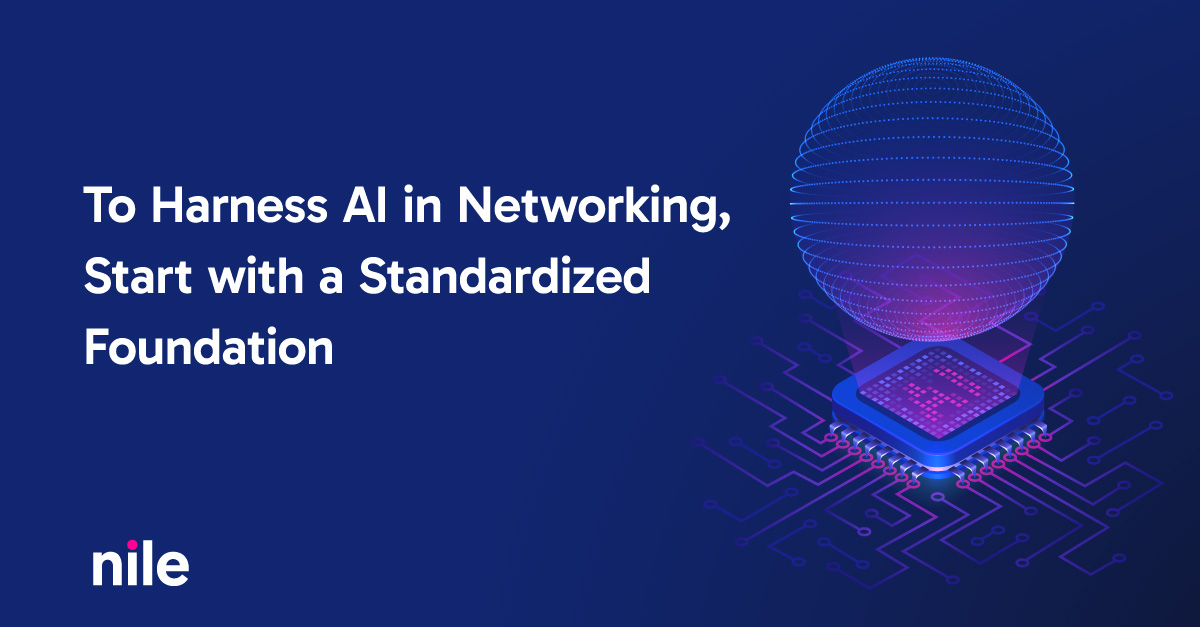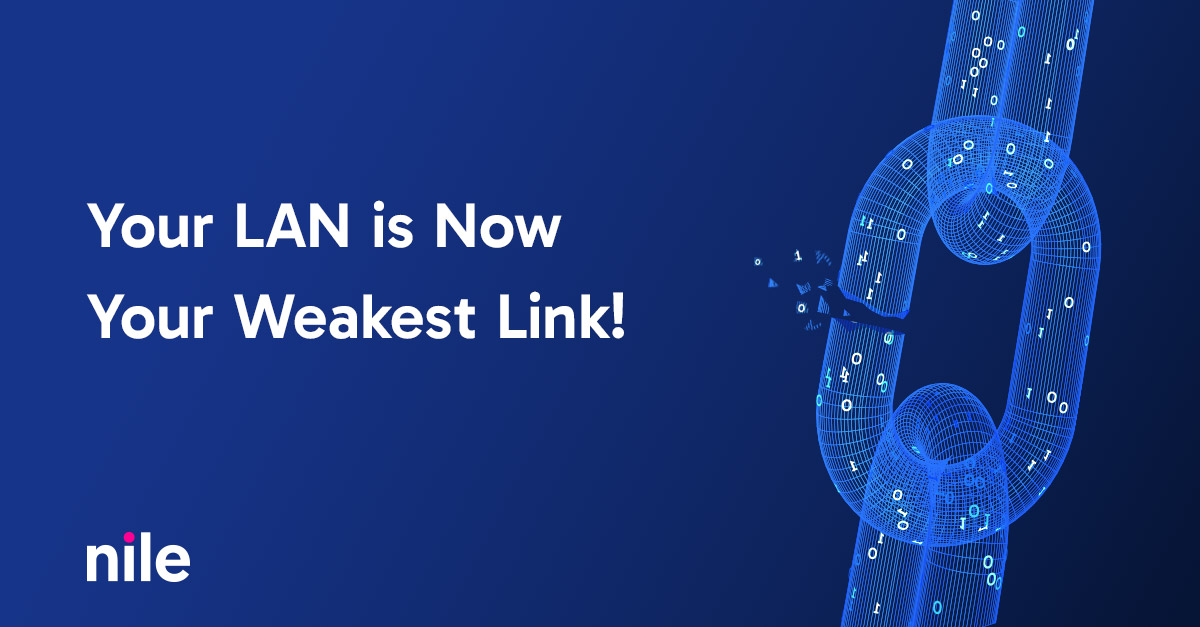Share Via
As I was putting together this blog, I had to sit back and reflect on the past. We’ve been working to disrupt the status quo in the networking industry and were recently recognized as visionary by Gartner in the 2025 Gartner MQ for Wired and Wireless LAN Infrastructure. It wasn’t by accident. We’ve always taken the approach that the legacy network model was broken.
It’s not uncommon for customers to be pitched a network architecture by others that contains well-known vulnerabilities, that requires a host of add-on security, AI, and orchestration tools offer some relief and protection. We believe that Campus Zero Trust security and Day 1 to Day N efficiency enabled by AI Automation should be built into your network foundation from the start.
Your network, which sits at the core of your organization and business, shouldn’t operate the same way it did 25 years ago. The following Nile Access Service enhancements build on our automation, security, and simplicity commitment—without the burden of complex or costly integrations.
Campus Zero Trust Security Enhancements
1. Palo Alto Networks Prisma SSE Integration
We’ve added the ability for customers to dynamically forward traffic from the Nile Access Service to Prisma for cloud-delivered security inspection—eliminating the need for external routers and/or manual tunnel configuration. This enables organizations to take advantage of consistent policy enforcement for every user and device (including IoT/OT), whether remote or on-site.
This is Ideal for IT organizations adopting cloud-delivered security where setup, operational overhead, and reliability concerns are not being met by their legacy network vendors.
2. Your SIEM just became more useful
Forwarding rule-based logs to a SIEM platform like Splunk from the Trust Engine within the Nile Access Service has been made easier and more useful. Simply click on the checkbox labeled “Send Trust Engine Rule Logs” and we’ll automatically stream all rule logs (both allow and deny actions) from the Trust Engine to your configured SIEM.
Not only does this help customers detect and respond to threats more quickly using their existing security operations infrastructure, but it also benefits any audit or compliance reporting.
3. A standardized schema adds to SIEM usefulness
All events now follow a standard schema, simplifying their parsing and ingestion by your SIEM. This unification of event formats across all Nile system components includes clear identifiers, timestamps, and metadata for effective search and correlation, while providing for enhanced security operations and network observability.
Structured event data decreases the time and effort needed to detect and respond to anomalies, which not only benefits IT teams but also makes things easier for your users.
4. MAC Auth Table Visibility
This feature ensures the MAC Auth table (previously, MAB Table) accurately displays the current authentication source of endpoints via 802.1X and MAC auth. We display the segment and auth source in the table and the current authentication state of endpoints, including:
- Dot1X Approved
- Mac Auth Approved
- Manual Admin Approved
- Rule-based approval (OUI/MAC/Fingerprint)
- SSO-based approval
The benefit is the ability to view and track how endpoints are onboarded, particularly when diagnosing authentication issues.
5. Improved Mac Auth Filtering
This enhancement provides very useful filtering and sorting capabilities for all of the MAC Auth table information you’re now receiving. A simplified search saves time by eliminating the need to scroll through sites or hundreds of MAC addresses, thereby improving IT’s ability to verify the authentication status of endpoints and resolve issues quickly.
AI Automation Enhancements
1. Easy to read endpoint client to AP mapping
If you’re troubleshooting a user issue, IT admins now have better visibility into the clients connected to each Access Point (AP). A visual also helps locate APs on a floor map, which streamlines troubleshooting, validation, and physical navigation during IT incidents. This map-based AP identification feature greatly enhances situational awareness in large, distributed, or multi-floor environments.
2. Good Roaming, Bad Roaming?
No more guesswork. New Roam Status visibility in the Nile Control Center helps IT teams quickly pinpoint and resolve roaming issues without sifting through logs. Origin and Destination APs are displayed to visualize handoff paths and identify coverage gaps. Accurate Timestamps allow fast correlation with reported issues or service degradation.
IT teams can now improve the end-user experience by pinpointing latency, connectivity issues, and dropped or slow handoffs that lead to help desk calls and lost productivity.
3. A visual PoE monitor
Customers can now visit the Switch Monitor page in the Nile Control Center to view all directly connected endpoints and the PoE draw from each device. This gives IT teams deeper insight—without the need for manual audits or third-party tools. It also removes the guesswork about how many extra endpoints can be added to a switch before exceeding the PoE budget, which could impact previously connected and functioning endpoints.
4. Enhanced Help Desk admin visibility
This ensures timely and actionable insights reach the right people without needing full admin privileges. Helpdesk and monitoring-only IT staff can subscribe to email alert subscriptions. Quicker awareness of critical events like internet outages, device failures, and policy violations enables faster response.
This is especially useful when on-site network admins are not present, such as on weekends.
5. Real-time internet outage visibility
The initial rollout of this enhancement is limited to customers in the U.S. and is focused solely on connectivity loss between the Nile Access Service and the internet. IT teams will now receive SMS-based alerts for any internet outages. This lets you know that it’s not the network, it’s the internet that’s down. Alerts will also be sent when an open issue is closed, indicating that the issue has been resolved.
This ensures that anyone responsible for monitoring a network and connectivity to internet services are promptly notified, even when not actively logged into the Nile Control Center portal.
6. Simplified guest onboarding
Customers using the Nile Guest Service can now create and publish a guest Wi-Fi passcode via the Nile Control Center, allowing guests to self-register and fast-track guest network access. Passcodes can be configured and set up with custom expiration windows, set to rotate, or never expire.
This reduces IT overhead by eliminating per-user approvals or manual guest provisioning, which is Ideal for large or dynamic environments that support events, shared spaces, and open campuses.
7. Custom guest portal branding
This allows organizations to tailor the Nile Guest Service login portal to reflect their branding, messaging, and expectation-of-use verbiage. IT can select from layout options, upload logos and images, and configure text fields as needed. Organizations often find that this enhances the opportunity to present a seamless, branded and informative experience that aligns with the organization’s identity.
Nile Nav: AI Automation, Activation and Deployment Enhancements
1. Wired device, site discovery collection
New per-site discovery & automation within the Nile Nav App gives organizations highly accurate wired infrastructure data—delivering useful management and BoM automation. Anyone on-site now easily collects key physical infrastructure details, including:
- Closets, racks, and rack units
- Essential assets like switches, patch panels, and UPS devices
- Coverage at both building and floor levels
- Device types and models
- Port counts and assignments
- Physical locations within buildings and floors
- Connectivity and cabling information
Having this data, as well as that of Nile APs, now allows for the accurate creation of Nile’s per-network AI-powered digital twin, for faster troubleshooting, future network planning and informed decision-making.
2. Improved IDF closet visibility
This enhancement streamlines getting information using the Nile Nav App needed for the Switch Closet. Includes the ability to perform:
- Floor-aware closet searches with filters and sticky headers
- Easily view floor IDs, closet counts, and location details
- Visual alerts for incomplete or an incorrect set up
- “View on Map” option to quickly see a location
3. A matching Wi-Fi device site discovery collection enhancement
This automated Wi-Fi design and data collection workflow in the Nile Nav App for network planning and deployment ensures Nile customers receive a network design that delivers an optimal user experience and resource utilization. IT organizations gain key design information that includes:
- Floor layouts
- Environmental attributes
- Essential RF parameters
- Ekahau file support for the direct import of antenna placements, RF requirements, and predictive models to streamline predictive survey workflows
This information is also used to populate and ensure the digital twin represents your actual network.
4. Improved Nile Nav responsiveness
We’ve made page refreshes faster, especially when working with large volumes of data. The App also delivers improved performance at scale, allowing network installers to navigate and manage jobs with less waiting and fewer interruptions. Intensive backend tasks are shifted to background processes, significantly reducing UI lag and freeing the interface to remain interactive during heavy operations.
5. Nile device factory resets
Lastly, we’ve made it easy for installers to reset devices to a clean firmware state with clear status feedback and retry options. The benefits include simplified installation workflows by ensuring each Nile device is brought-up cleanly and that activations happen smoothly.
If you have any questions or want to learn more about any of these features please review a more in-depth Feature Update document here.




